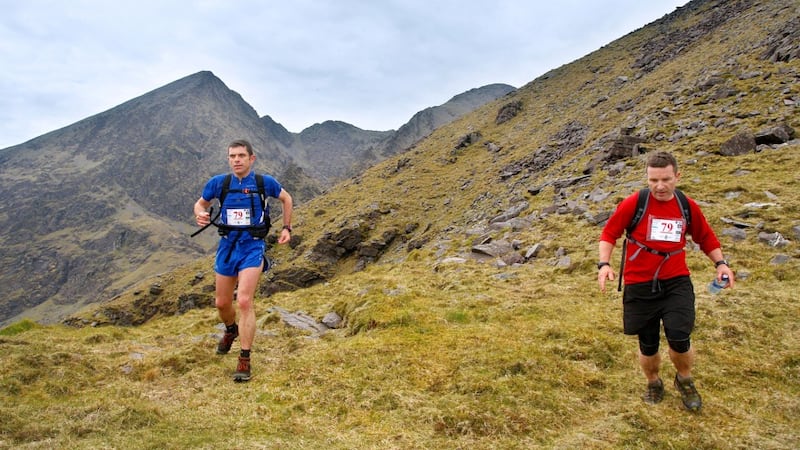Mountain running requires a different approach to training, but what better reward is there for a tough session than a glimpse from Ireland's highest point?
I GOT up at 6am last Sunday week to witness a day that was as inviting as a dirty dish cloth. The rain was teeming down in Dublin. It teemed down for every bit of the 300km journey I travelled that morning. And it was still teeming down when I pulled my car into a farmyard in the Brida Valley deep in Kerry’s Iveragh Peninsula sometime after 11am.
About 7km to the east and 1,039 metres higher lay the goal, Corrán Tuathail. I wasn’t alone. About 50 others kitted out in shorts and fell running shoes had assembled in the yard. This was the annual Irish Mountain Running Association (Imra) race up the country’s highest mountain. And trifles like flooding and a deluge weren’t going to deter these hardened athletes.

Today, with cloud cover down to about 300 metres, the only views that would be guaranteed would be thick rumbling mist and rain. The route would follow a bit of the Kerry Way, before climbing up the western slopes of the 1,000-metre-high Caher. From there it would cross a rough (and occasionally precipitous) ridge to the summit of Tuathail, with its massive summit cross. You get to savour being at Ireland’s highest point for about two seconds. For the descent, the runners retraced their steps (some at a frightening pace).
Given the mountain’s status and its tough terrain, the race is one of the most coveted and prestigious in Imra’s calendar. One figure has dominated the 26-year history of the race. He is the extraordinary Kerry mountain runner John Lenihan (also a world champion) who has won it 19 times. His course record for the more than 13km race (with almost 1,000 vertical metres) stands at 71 minutes 43 seconds. For amateurs like us who struggle up the summit, his is a mind-boggling achievement.
Though I had climbed this mountain many times before, it was my first time running it and the route from the west was one I had never done before. Navigation looked like it would be tricky. So would fitness.
My own trip up and down took a little over 2.5 hours, with a bit of an unscheduled detour in poor visibility on the descent. The ascent was a bit of a slog, but the descent allowed for a lot of running with a fair bit of sliding through boggy pools and mud. The rain had ceased and despite no view, it was still exhilarating. An hour further down the mountain Tuam man Brian Furey and Rob Cleary had been fighting an epic shoulder-to-shoulder battle from the beginning, with Furey besting Cleary by three seconds to win the race. An amazing day and race despite the elements.
Imra is a great organisation which represents volunteerism at its best. On Corrán Tuathail, two race helpers sat at chilly summit tops for more than five hours recording those who passed. The association runs a full calendar of races, from easy trail runs to rough and tough races across open terrain to the highest peaks in Ireland. It caters for all age groups (one of the competitors on Corrán Tuathail was in his 70s) and all capabilities. Taking part in its races opens up eye-enticing mountainous terrain throughout the country. It sounds daunting but it’s not, though navigation skills, endurance and mountain-confidence would be needed for the longer and more technical races.
There are training and techniques that can help runners improve on the mountains. Imra’s president Dermot Murphy, himself an elite runner, has emphasised the importance of interval training – interspersing high-speed intervals with more relaxed pace – as a means of improving on ever-changing terrain.
Another elite runner, Turlough Conway, says that long days in the hills are necessary to build up endurance and confidence. The Sligo runner recommends that you try to run for as long as you can uphill (even at a crawl) to build up your endurance. “For descending you also need a long run where you can relax on the descent and just go with gravity and getting your eye in.”
Good hill runners are amazingly fast descending even horribly rough and steep ground. They obviously have confidence, good balance, and a good eye for each step. They also try to glide down. Another unusual technique you see some runners doing is placing their hands on their knees as they walk up very steep ground. This takes some weight off the legs and makes it a little less punishing.
Tips for getting into the hills
* Turlough Conway is in the process of establishing a hill-racing group in Connaught. See iti.ms/LBLGTf
* Practice running (very slowly if necessary) for as long as possible up a gradient.
* You need to spend time in hilly environments building up muscle and endurance strength for ascending and descending.
* Get proper shoes and kit. A huge variety is available, from trail shoe to fell shoe, with studs and no cushioning. A common feature is they protect toes from impact. Hill runners tend to kit-up as lightly as possible. But a mountain list should include a light waterproof jacket, map, whistle, suncream, compass, long leggings, gloves and hat.
* For newcomers, start relatively gently. Imra organises enjoyable Wednesday evening races in Dublin/Leinster and Munster.














